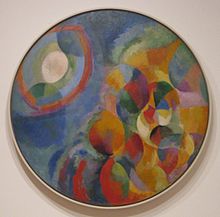Orphic Cubism

The term Orphism or Orphic Cubism (derived from the mythical singer and lyre / lyre player Orpheus , French orphique , `` mysterious '') describes an art movement that emerged from Cubism , in which circular shapes in bright colors based on the color theory of the chemist Michel Eugène Chevreul , described in his book Law of Simultaneous Contrasts in Colors , published in 1839 . The term was coined by Guillaume Apollinaire in 1912 after the colorful works by Robert Delaunay . In the Cubist paintings of Pablo Picasso and Georges Braque at that time, a more monochrome color scheme prevailed .
history
The name Orphism was coined in 1912 for Robert Delaunay's pictures by the writer Guillaume Apollinaire , who in the same year gave an introduction to the Delaunay exhibition in the gallery Der Sturm by Herwarth Walden . Apollinaire saw an overcoming of Cubism in Orphism and praised the painting of Delaunay, František Kupka and other young painters of late German Expressionism as a “poetic and musical” language. The aim of Orphism was to oppose pure music with pure painting, which should be broken down from the representational into a rhythmic color harmony. The means of design are the dynamic forces of color, so color and its spatial effect are essential elements of the composition. Light not only creates color, it is color itself.
The simultaneous contrast , the simultaneous presentation of warm and cold, complementary and in the spectrum of neighboring colors are an essential stylistic device of Orphism. Their optical effects should create the impression of movement in the eye of the beholder.
Robert Delaunay, who called his style Cubisme écartelé (divided cubism), developed in 1912 , was the most important representative of this art movement. Delaunay saw, and explained this in extensive art-historical writings, in the color his actual pictorial material, from which the pure painting should arise, which could “dispense with the objects” and “be completely abstract.” While Chevreul used his theory as a guide for artists understood, so Delaunay, who read the book during his military service as regimental librarian in Laon , developed his artistic concept from Chevreul's theory, which for him was the expression of a worldview and which he accepted as binding. For him, the idea of pure color painting was the necessary idea of a universe and the associated idea of reality, "which can only be adequately recognized through optical perception and shows itself as the simultaneous movement of colors in light."
In this way painting should be newly established as a means of knowledge and the rank of the painter reassessed, because only the painter is in a position not only to see this reality but also to convey it. Delaunay remarked about his window pictures that behind each of these windows lies a new reality, which is the ABC of possibilities of expression, which uses the physical elements of color and from which the new forms can be created. "In this painting one still encounters hints that are reminiscent of nature, but in a general sense, not in an analytical and descriptive one as in the previous Cubist epoch."
Especially Sonia Delaunay-Terk and the American Patrick Henry Bruce , a student of Henri Matisse , were influenced by Orphism in their work. In addition, works by Marc Chagall , Raymond Duchamp-Villon and members of the Blue Rider and the Section d'Or should be inspired by Orphism.
literature
- Claudia List-Freytag (ed.): Keyser's Grosses Stil-Lexion Europa. 760 to 1980 . Keysersche Verlagsbuchhandlung, Munich 1982, ISBN 3-87405-150-1
Web links
- Orphism BeyArs.com
Individual evidence
- ↑ Karin Thomas: DuMont's small non-fiction dictionary on the art of the 20th century. From anti-art to zero . DuMont Buchverlag, Cologne 1977, p. 179
- ^ Robert Delaunay - Sonia Delaunay: The Center Pompidou visits Hamburg . Catalog for the exhibition in the Hamburger Kunsthalle , Hamburger Kunsthalle 1999, ISBN 3-7701-5216-6 , p. 92
- ↑ a b Orphism
- ↑ a b c Claudia List-Freytag (Ed.): Keyser's Grosses Stil-Lexion Europa. 760 to 1980 . Keysersche Verlagsbuchhandlung, Munich 1982, p. 459
- ^ Robert Delaunay, quoted from: Claudia List-Freytag (Ed.), Munich 1982, p. 459
